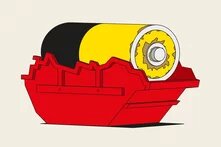Saudi Arabia's climate policy is ever more oriented towards green mega projects and high-profile investments in hydrogen, but is it a mere rebranding of existing energy policies? Read the piece by our 2024 Climate Disinformation Fellow Lyse Mauvais.

Long decried as one of the world's biggest emitters of greenhouse gasses and a notorious blocker at international climate negotiations, Saudi Arabia is now positioning itself as a leader in the global energy transition, with hydrogen at the heart of its strategy.
Since Crown Prince Mohammed bin Salman’s accession to power in 2017, Riyadh has showered the region with announcements of high-profile “green” mega projects. The kingdom also declared its ambition to turn into one of the largest exporters of hydrogen, presented as a sustainable alternative to oil and gas. It has since taken steps toward that transition and invested massively in export-oriented hydrogen projects, unveiling plans to open the world’s largest green hydrogen plant in the futuristic megacity NEOM.
Yet this grand green transition has murkier undertones. As it bets on hydrogen, Saudi Arabia is hoping to usher in a new economic order compatible with mounting calls for decarbonisation: one in which former fossil fuel giants, converted into hydrogen exporters, manage to retain their crucial role at the heart of global energy networks. Can this bet pay off? And what’s at stake for Saudi Arabia and other economies in the region?
From climate obstruction to action
Saudi Arabia’s makeover as a sustainability champion accelerated sharply after 2017, when it launched multiple initiatives under the banner of Vision 2030, Prince Mohammed’s grand plan to diversify the Saudi economy away from oil.
Some of these flagship projects include the Saudi Green Initiative (which aims to plant 10 billion trees across the country over the next decade), the Middle East Green Initiative (a regional approach led by Saudi Arabia to mitigate the effects of climate change), Red Sea Global (tourism and real estate development coupled with coral reef restoration projects) and a flurry of lesser-known conservation projects.
But the crown jewel of the Vision 2030 portfolio is undoubtedly NEOM, a region the size of Belgium being built in the kingdom’s western desert, sharply criticised abroad for human rights abuses associated with its construction.
Designed to host a ski facility, an industrial zone, a shipping port and over 9 million residents, NEOM is also presented as a 100% carbon-neutral initiative — though it has yet to publish a detailed plan on how it will achieve its goals. Official communication claims it will be entirely powered by renewable energy, with hydrogen playing a crucial role to store intermittently produced wind and solar power as a gas, usable on demand. NEOM is intent on producing it for export as well: In 2020, it unveiled the NEOM Green Hydrogen Company, billed as the world’s future largest green hydrogen plant.
Saudi Arabia’s new stance on climate policy is also illustrated by the changing communication strategy of Saudi Aramco, the kingdom’s state-owned oil giant, which started to issue the first sustainability reports in its history in 2021. In it, the company announced its intention to achieve “net-zero scope 1 and scope 2 gas emissions across our wholly owned and operated assets by 2050.” This target, however, leaves out “scope 3” or end-user emissions, which in the case of Aramco, are estimated to make up at least 85% of overall emissions.
Despite plans to expand fossil fuel production in the coming years (eyeing a 60% increase in its natural gas production by 2030), Aramco’s sustainability reports emphasise its investments in research and development to develop carbon capture, hydrogen and synthetic, “low-carbon” fuels also called synthetic fuels. This strategy culminated with its first export of “certified low-carbon ammonia” derived from hydrogen to Japan in 2023, which remains marginal compared to conventional oil and gas activities.
In line with Saudi Arabia’s broader diversification strategy spearheaded by the crown prince, Aramco has partnered with NEOM and other Saudi companies along related value chains. It invested in a pilot synthetic fuel production plant in NEOM which simultaneously struck partnerships with mobility startups and automotive producers to develop cars or planes powered by hydrogen and synthetic fuels.
Aramco and the Saudi Ministry of Energy did not respond to requests for comment.
Multifaceted strategy
Are these changes more than a cosmetic makeover? Saudi Arabia remains the second-largest oil producer globally, according to the US Energy Information Administration, and is intent on pumping its hydrocarbons down to the last drop, as Saudi officials have stated repeatedly. So is Aramco, the world’s largest corporate greenhouse gas emitter, whose CEO recently stated that the world “should abandon the fantasy of phasing out oil and gas.”
Attentive to this dual discourse, critics warn that through symbolic projects like NEOM’s green hydrogen plant, Riyadh is projecting the illusion that it is transitioning away from oil while promoting an alternative that could be equally dirty.
Saudi leaders have recognised they don’t plan to immediately divest from oil, which generates up to 70% of state revenues. Riyadh hopes that winning the hydrogen race and becoming the most efficient producer of hydrogen globally will help it reduce emissions domestically. But its current investments in the sector will not replace oil production, at least not before decades.
Rather, the colorful palette of potential hydrogens offers the kingdom endless possibilities to maximise revenues from existing oil and gas assets — which it can market as temporary lower-carbon alternatives to current fossil fuels.
Hydrogen, the most abundant element in the universe, can be created by splitting water or gas molecules and isolating their hydrogen element. It comes in various colour designations, denoting different production methods and their associated emissions.
Green hydrogen, obtained from water by electrolysis powered by renewable energy, is presented as the most sustainable option because it doesn’t release carbon when produced or burned.
Blue hydrogen, whose production releases significant greenhouse gasses, is derived from hydrocarbons by splitting hydrogen from carbon, a portion of which is then “captured” to reduce emissions. By contrast, grey hydrogen is generated from hydrocarbons without carbon capture, leading to even higher emissions. Today, less than 1% of hydrogen produced worldwide is green.
Green is far from the only colour on Riyadh’s sustainability palette. The state-owned Saudi Aramco is also investing in blue and grey hydrogen as ways to extend the lifespan of its extensive oil and gas assets. Aramco aims to position itself as a leader in what it calls “lower-carbon” hydrocarbons — using controversial carbon capture technology to partially abate emissions associated with extraction or producing hydrogen from hydrocarbons.
“The success of the transition to a lower emissions future will also hinge on the availability of multiple lower carbon options,” Aramco’s latest sustainability report released in 2023 states. “That is why we are pursuing the development and deployment of technologies and tools that can contribute to global emission reduction efforts, including … blue hydrogen.”
Eyeing Europe
With its 100% renewables-based production, the NEOM Green Hydrogen Company is the main showroom of Riyadh’s expanding hydrogen strategy. And despite recently announced setbacks in some of NEOM’s other high-profile initiatives such as The Line, it seems to remain on track for completion by 2026.
Saudi authorities recently announced severe setbacks to some of NEOM’s other high-profile projects such as The Line, a 170-km long city, which will be under 2% built by 2030, its initial completion date. But though market challenges have led Riyadh to re-“prioritise” the construction of NEOM’s various components, the hydrogen plant is still on track for completion by 2026.
The company, a joint venture between NEOM, the partly state-owned Saudi energy giant ACWA Power and US-based Air Products, reached financial closure last May, attracting over $8 billion in investments from over 23 financial institutions. The deal was closed after Air Products agreed to buy the plant’s whole production over the next 30 years, up to 600 tons of hydrogen per day, primarily destined for export. That would amount to nearly 220,000 tons produced per year, more than the current global green hydrogen production, which just hit 150,000 tons per year.
The target is extremely ambitious — some would say utopian — considering that green hydrogen is still in its infancy. Yet observers from the sector are confident. “We have no concerns in terms of feasibility,” Jorgo Chatzimarkakis, CEO of Hydrogen Europe, an industry network of European hydrogen producers, told Al-Monitor. “Hydrogen technology of the kind used in this project is mature and proven.”
Yet with nine liters of fresh water required at the very least for every kilogram of hydrogen produced, it seems legitimate to question where the 5.4 million liters required daily to operate the plant will come from in one of the world’s driest regions.
Another obstacle is financial viability. To achieve its ambition of becoming a key hydrogen exporter as demand for fossil fuels wanes, Saudi Arabia needs a global market. This objective is already central to the kingdom’s foreign policy and well integrated into Aramco’s corporate strategy.
As a steering member of the Hydrogen Council, a global initiative founded in Davos in 2017 by large energy companies to promote hydrogen’s role in the energy transition, Aramco is actively trying to shape future hydrogen markets and lobbying policy-makers to promote its interests. Its influence extends to Europe through oversea subsidiaries and partners, several of which are members of Hydrogen Europe, which lobbies for public subsidies for hydrogen infrastructure across the continent. One of the aims is to connect Europe to potential producers in the Middle East, such as NEOM.
“Imports will undoubtedly be needed to fulfill European demand,” Chatzimarkakis said. “Morocco, Egypt and Saudi Arabia are committed to delivering high volumes of renewable hydrogen and ammonia, with European users of hydrogen their most likely buyers. Their proximity to Europe and the existing gas pipelines and trade routes between them make it affordable and realistic to do so.”
But whether European demand will grow as projected by industry players remains to be seen. Multiple ambitious green hydrogen projects were recently rolled back in Europe due to a lack of market demand, with some European industries warning green hydrogen is still too expensive for them to use, despite massive subsidies.
So despite the hype, the future of green hydrogen as a global commodity is more than misty. Saudi Arabia’s aggressive push into this market is driven by determination to maintain a central role in the evolving global energy landscape, but the bet could well devolve into unfulfilled promises. In the meantime, the world is watching as regional powers in the Gulf navigate a shifting energy landscape fraught with green promises and often unrealistic targets.
Research for this piece was supported by the Heinrich-Böll-Stiftung European Union. The views and opinions in this article do not necessarily reflect those of the Heinrich-Böll-Stiftung European Union.
This article first appeared in English here.


